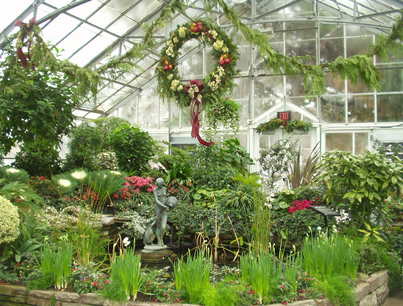by Amanda Moon
Christmas and other winter holidays bring out the desire to fill
our homes with greenery and decorative flowers. With a little
extra care and forethought, many of these wonderful plants can
continue to thrive long after December becomes just a distant
memory.
Choosing a living Christmas tree is a great place to start.
You can have it indoors for the holiday season, and then enjoy
it for the rest of the year as a beautiful addition to your landscape.
The trick is to choose the right type of tree that can survive indoors
for three weeks or so, and then thrive in our soil and climate.
Some options to consider are Leyland Cypress and Arizona Cy-
press. If you live in the Elgin-Bastrop area then the Afghan Pine
is a good choice. It will grow west of that area, but will not grow
quite as strong because of our alkaline soil.
Hollies and asparagus fern are two other outdoor plants that look
pretty when decorated for winter and are then planted in the land-
scape. Just make sure you give them even water while still in the
containers, and remove any decorative sleeves that prevent water
from draining (or punch holes in the bottom).
If you're looking for a permanent indoor or porch tree, then the
Norfolk Island pine can be a nice addition that you can decorate
for Christmas and then use as a centerpiece of your indoor green-
ery for the next year.
Rosemary Christmas trees are always available this time of year
and many people buy them for centerpieces in their home. How-
ever there is a problem with this: rosemary absolutely has to be
in the sun and will crash if kept inside for more than a few days
(at most). But in a sunny spot on the porch it will thrive and then
you can plant it as a full sun, evergreen anchor piece in your land-
scape after Christmas.
Greenery on your porch can also add to your outdoor decorations
and looks beautiful when it's decked out in lights and ribbons.
A native of Mexico, poinsettias have been an important part of the
Christmas tradition in that country for nearly 500 years.
Brought into the United States in the mid-19th century, we have
enjoyed their colorful bracts in our homes each December now
for generations. Poinsettias are typically grown for the holidays
and then discarded in January after the season is over.
If you want to keep your poinsettia growing, water only enough
to keep the leaves from wilting. Too much water (especially when
covered in non-draining metallic florist sleeves) is the biggest
detriment to keeping your poinsettia looking its best throughout
December and into the new year.
After all danger of frost has passed, gradually move the pot out
to a shady location on a porch and repot into a bigger container.
When handling poinsettias wear gloves if you are sensitive to the
milky sap produced by the Euphorbia family. The sap can be an
irritant to some and can irritate a pet’s mouth if eaten.
Finally, Christmas cactus and amaryllis are two of my favorite
holiday plants. They're easy to grow and will reward you with
years of blooms with little care.
Amaryllis is a true bulb that typically bloom in the late spring.
I buy a new one every year and plant them into large mixed tubs
to create a beautiful spring display. My favorite varieties? Apple
Blossom and Papilio. Many amaryllis can be planted in the ground
here and will overwinter and multiply in all but the coldest years
(then just protect temporarily).
Christmas cactus is a succulent that will bloom the next Christmas
with just a little care. Be careful not to leave the plant in the foil
sleeve it comes in. Too much water will kill it quick! In January
pot it up into a clay pot with a good draining soil. Grow in an east-
ward / northward facing location and water only when dry. Buds
should start to form again early the next December. A little organic
fertilizer will help it to bloom even stronger.
With just a little care, your plants purchased during the holiday
season can become a source of beauty into the new year.
Happy Gardening Everyone!





